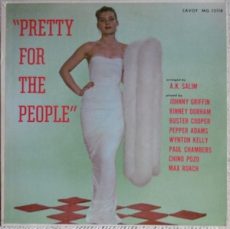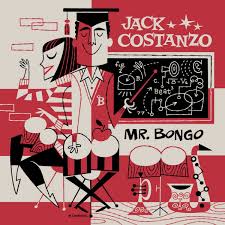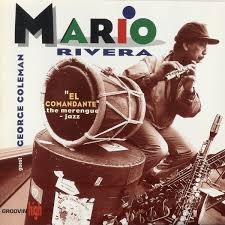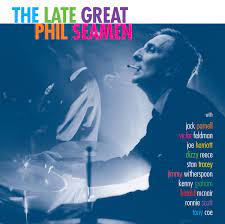
Daily Dose Of Jazz…
Francisco “Chino” Pozo was born on October 4, 1915 in Havana, Cuba. An autodidact on piano and bass, he concentrated on bongos, congas, and drums before leaving his home for greener pastures. Moving to the United States in 1937, he played with Machito from 1941–43 and with the Jack Cole Dancers from 1943-1949.
In the Fifties he went on to play in numerous jazz ensembles, especially latin jazz and Afro-Cuban jazz. He performed and/or recorded with Jose Curbelo, Noro Morales, Tito Puente, Tito Rodríguez, Enric Madriguera, Perez Prado, Josephine Premice, Tadd Dameron, Charlie Parker, and Dizzy Gillespie.
He toured with Peggy Lee in 1954-55 and played with Stan Kenton in 1955, Herbie Mann in 1956, Xavier Cugat and René Touzet in 1959.
He also recorded with Illinois Jacquet, Phineas Newborn, Gábor Szabó, Paul Anka, Justo Betancourt, Harry Betts, Fats Navarro, Eddie Palmieri, Johnny Richards, A. K. Salim, Billy Taylor, Clark Terry, Chico O’Farrill, Julius Watkins and Charlie Rouse.
Drummer Chino Pozo, whose claim to be the cousin of Chano Pozo has been disputed, died on April 28, 1980 in New York City.
More Posts: bass,bongo,conga,drums,history,instrumental,jazz,music,piano

Daily Dose Of Jazz…
Jack James Costanzo was born on September 24, 1919 in Chicago, Illinois to Italian parents. Starting his career as a dancer, he toured as a team with his wife before World War II. After his discharge from the Navy, he worked as a dance instructor at the Beverly Hills Hotel, where Latin band leader Bobby Ramos heard him playing bongos in a jam session and offered him a job.
He visited Havana, Cuba three times in the 1940s and learned to play Afro-Cuban rhythms on the bongos and congas. Throughout the 1940s, Costanzo worked with several Latin bands, including a revived version of the Lecuona Cuban Boys, Desi Arnaz, and Rene Touzet.
Jack toured with Stan Kenton from 1947 to 1948 and occasionally in the 1950s, and played with Nat King Cole from 1949 to 1953. He also played with the Billy May Orchestra, Peggy Lee, Danny Kaye, Perez Prado, Charlie Barnet, Pete Rugolo, Betty Grable, Harry James, Judy Garland, Patti Page, Jane Powell, Ray Anthony, Martin & Lewis, Frances Faye, Dinah Shore, Xavier Cugat, Frank Sinatra, Tony Curtis, and Eddie Fisher.
Costanzo formed his own band in the 1950s which recorded and toured internationally. Hollywood stars Marlon Brando, Rita Moreno, Carolyn Jones, Hugh O’Brian, Keenan Wynn, Van Johnson, Tony Curtis, Betty Grable, Vic Damone, James Dean, and Gary Cooper among others, studied bongos with him.
He went into retirement until 1998 when he decided to make a comeback. In 2001 he recorded Back From Havana featuring Gilbert Castellanos, Steve Firerobing and singer Marilu. In 2002 he released his sophomore album with the same cast called Scorching The Skins. He continued to tour and perform in California and abroad.
Percussionist, dancer, composer and bandleader Jack Costanzo, nicknamed Mr. Bongo, died of complications from a ruptured abdominal aortic aneurysm at his home on August 18, 2018 in Lakeside, California at the age of 98.
More Posts: bandleader,composer,history,instrumental,jazz,music,percussion

Daily Dose Of Jazz…
Mario Rivera was born on July 22, 1939 in Santo Domingo, Dominican Republic and learned to play during his childhood. Moving to New York City in 1961 at 22 he started working with singer Joe Valle as his accompanist. He spent two years with bandleader Tito Rodríguez. During his career he worked with Mongo Santamaria, Eddie Palmieri, and Machito.
From the 1970s to the 1990s he worked with Tito Puente. Both appeared in the films Calle 54 and The Mambo Kings. In 1988 he became a member of the United Nations Orchestra led by Dizzy Gillespie. He was also a member of the Afro-Cuban Jazz Band led by Chico O’Farrill. His only solo album, El Commandante, was released in 1996.
He recorded seventy-six albums as a sideman with Willie Colon, Cheo Feliciano, Dizzy Gillespie, Kip Hanrahan, Conrad Herwig, Giovanni Hidalgo, Chico O’Farrill, Eddie Palmieri, Tito Puente, Tito Rodriguez, Típica 73, Africando, Alfredo “Chocolate” Armenteros, Soledad Bravo, George Coleman, Junior Cook, Rafael Cortijo, Tito Gomez, Jerry Gonzalez, Juan Luis Guerra, La Lupe, Machito, Arturo O’Farrill, Pat Patrick, Bobby Paunetto, Daniel Ponce, Louie Ramirez, Paquito D’Rivera, Alfredo Rodriguez, Mongo Santamaria, Laba Sosseh, Juan Pablo Torres, Stanley Turrentine, Dave Valentin, Fernando Villalona, and Pete Yellin.
Saxophonist Mario Rivera, who also played trumpet, flute, piano, vibraphone, congas, and drums, died from cancer on August 10, 2007 in New York City.
More Posts: bandleader,congas,drums,flute,history,instrumental,jazz,music,piano,saxophone,trumpet,vibraphone

Daily Dose Of Jazz…
Philip William Seamen was born on August 28, 1926 in Burton upon Trent, Staffordshire, England. He began playing drums at the age of six, turning professional at the age of 18 by joining Nat Gonella and his Georgians in 1944. At 20 he spent a year with Gordon Homer Big Band at the Coronation Ballroom in Ramsgate. He joined the Tommy Sampson Orchestra in 1948 and by 1949, Seamen and tenor saxophonist Danny Moss formed a bebop quintet from within the ranks and was featured on a radio broadcast by the orchestra.
He then went on to play in the Joe Loss Orchestra for about 14 months before taking the top job with Jack Parnell from 1951 until midway 1954. Seamen, being much sought after during the 1950 played in Kenny Graham’s Afro-Cubists projects from 1952 to 1958, from 1954 onwards with the Joe Harriott Quartet, the Ronnie Scott Orchestra and Sextet. He was recruited opn countless sessions as well to perform with Dizzy Reece, Victor Feldman, Jimmy Deuchar, Kenny Baker, Vic Ash, Don Rendell, Stan Tracey, Laurie Johnson, Big Bill Broonzy and Josh White, to name a few.
In 1957 Phil was on his way to America with the Ronnie Scott Sextet as part of a Musicians’ Union exchange tour deal. Unfortunately the Southhampton custom officers found him in possession of drugs, killing his lifelong dream of visiting the States. In 1958, the West End production of West Side Story opened with him after Leonard Bernstein reputedly specifically asked for him, so the producers hired him.
During the first half of the 1960s, he worked often with Tubby Hayes, Joe Harriott, played a couple of nights with Dexter Gordon at Ronnie Scott’s, and recorded with Carmen McRae. In 1964 he played R&B with Alexis Korner and Georgie Fame.
He started teaching in 1962, one of his pupils being Ginger Baker, who went on to influence a whole generation of rock drummers. However, his addiction to alcohol, heroin and other drugs hampered his health and career as many bandleaders refused to hire him with the exception of Freddie Hubbard in 1964 and Roland Kirk in 1967 with a UK tour. On October 13, 1972 drummer Phil Seaman transitioned in his sleep at his home in Old Paradise Street Lambeth, South London, at the age of 46.
Bestow upon an inquiring mind a dose of a Burton upon Trent drummer to motivate the perusal of the genius of jazz musicians worldwide whose gifts contribute to the canon…

Daily Dose Of Jazz…
Lyman Woodard was born on March 3, 1942 in Owosso, Michigan. He started his musical career with a trio with drummer Melvin Davis and guitarist Dennis Coffey. They recorded the album Hair And Thangs that was released under Coffey’s name, however a single with It’s Your Thing and River Rouge was released under the name of Dennis Coffey and the Lyman Woodard Trio.
From the late 1960s, Woodard recorded with Motown acts, and served as musical director for Martha and the Vandellas. Establishing the jazz~funk band, the Lyman Woodard Organization in 1975 recorded Saturday Night Special, and in 1979, he recorded Don’t Stop The Groove, for the Corridor label. His 1987 recording, Dedicacion, featured violinist Regina Carter.
In March 2009, Wax Poetics Records reissued a limited pressing of his Saturday Night Special as a double LP on 180-gram vinyl.
Organist Lyman Woodard, who was based in Detroit, Michigan and was known for his ability to fuse Latin and Afro~Cuban inspired rhythms, transitioned on February 25, 2009 in his hometown of Owosso.
More Posts: bandleader,history,instrumental,jazz,music,organ,piano





